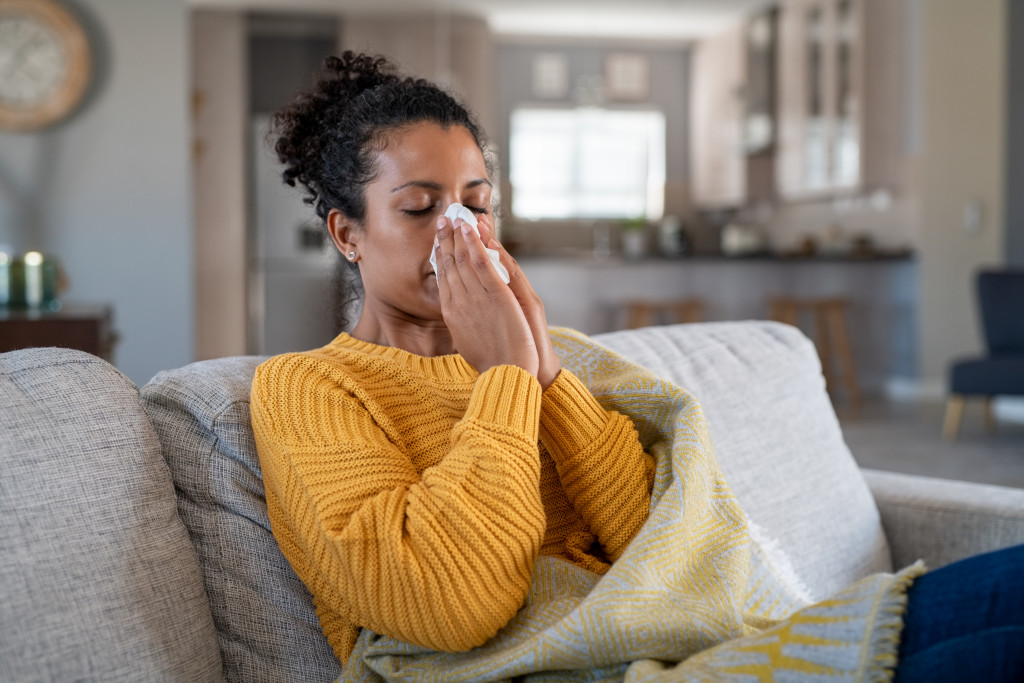- Improve indoor air quality by avoiding smoking, using natural cleaning products, and hiring a professional duct cleaning service
- Pet care and allergen management are essential for preventing allergies.
- Invest in hypoallergenic bedding and furniture to create an allergy barrier.
- Clean regularly to reduce allergens in the air.
- Choose washable curtains, blinds, and furniture made from hypoallergenic materials to minimize allergen exposure.
Allergies are a common health issue that can affect your quality of life, especially if you’re in your own home. The good news is that there are practical steps you can take to reduce the risk of allergies in your house. This guide will provide five tips on preventing allergies at home so that you and your family can enjoy fresh air free from triggers like dust, pet dander, and mold.
1. Improve Indoor Air Quality
Indoor air quality plays a significant role in preventing allergies. Dust, pollen, and other allergens can be present in the air, leading to respiratory discomfort.
Here are some ways to improve indoor air quality:
Hire a Professional Duct Cleaning Service
Utilizing professional duct cleaning to clean your air ducts regularly and thoroughly is one of the best ways to reduce allergens at home. Professionals have the experience and tools to eliminate dust, pet dander, mold spores, and other contaminants that can trigger allergies. They will also inspect and clean the AC coils, fan blades, and other areas prone to dust accumulation.
Install an Air Purifier

Air purifiers are designed to filter out allergens from the air in your home, making it easier for you to breathe. Choosing an air purifier with a high-performance rating and compatible with your HVAC system is important. A good air purifier will help reduce airborne allergens and improve indoor air quality.
Clean or Replace Air Filters Regularly
Regularly cleaning and replacing air filters in your vents, fans, and other HVAC systems can help reduce the amount of airborne pollutants. Make sure to check the manufacturer’s instructions for recommended cleaning frequency.
Open Windows to Ventilate Your Home
Opening windows and doors for a few minutes daily can help bring in fresh air and remove pollutants. This is an easy and cost-effective way to improve indoor air quality. Additionally, you can purchase a dehumidifier if your home has excessive humidity levels, which can lead to mold growth.
2. Pet Care and Allergen Management
If you have pets or are considering getting one, proper pet care is essential to prevent allergies. Regularly bathe and groom your pets to reduce dander, a common allergen. Designate pet-free areas within your home, especially bedrooms and other frequently used spaces, to minimize exposure to allergens. Wash pet bedding, toys, and accessories regularly to avoid allergens. Consider using a HEPA air purifier to capture airborne pet dander effectively. Finally, use pet fur, dander, and saliva repellents to reduce allergen buildup on furniture and carpets.
Pets tend to bring in allergens from the outdoors. To reduce outdoor allergen exposure, keep your pets away from grass and weeds or bathe them immediately after being outside. Check for ticks and fleas regularly to prevent these pests from spreading through the home. Additionally, ensure pet doors are well-sealed so pollen cannot enter.
3. Allergen-Proof Your Bedding and Furniture
Your bedding and furniture can harbor many allergens, affecting your sleep and overall well-being. Invest in hypoallergenic mattresses and pillow covers to create a barrier against dust mites and allergens. Wash your bedding, including sheets and pillowcases, in hot water at least once weekly. Opt for hardwood or tile flooring instead of carpets, which can trap allergens, making it difficult to remove them effectively. If you prefer carpeting, choose low-pile options and clean them regularly using a vacuum cleaner with a HEPA filter.
4. Clean Regularly to Prevent Allergies

Regular cleaning and maintenance are essential for preventing allergies at home. Dusting surfaces such as tables, shelves, and other furniture help reduce allergens in the air. Remember to clean areas often overlooked, including baseboards and ceiling fans. Vacuum carpets weekly using an allergen-eliminating vacuum cleaner. And don’t forget to mop hard floor surfaces with an allergen-reducing solution.
5. Choose Allergy-Friendly Decor
Your decor choices can have a significant impact on allergy prevention at home. Use washable curtains and blinds instead of heavy drapery that can collect dust quickly. Opt for furniture made with hypoallergenic materials such as leather or vinyl to minimize exposure to dust mites. To promote air ventilation, open windows regularly and install exhaust fans in the kitchen and bathrooms. Additionally, choose light colors when painting walls and surfaces to reduce allergen accumulation.
In Closing
Following these five tips, you can easily create an allergy-free home and improve indoor air quality. Small steps towards improving your environment, such as regularly cleaning and using appropriate decor choices, can significantly prevent allergies. You can enjoy a healthier and more comfortable lifestyle with the right strategies
